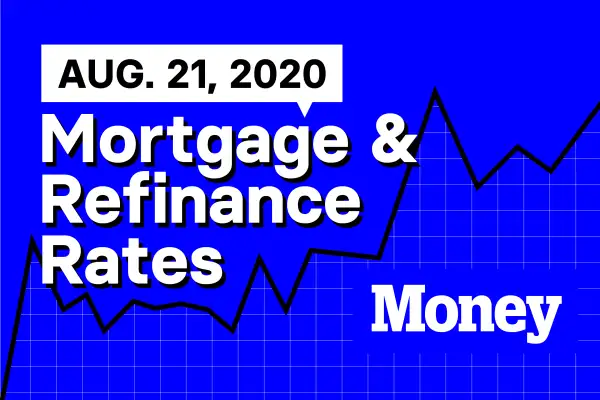Here Are Today's Best Mortgage & Refinance Rates for August 21, 2020

Borrowers with 700 credit scores were quoted an average rate of 3.474% to secure a 30-year fixed-rate purchase mortgage on Thursday, according to Money's survey of over 8,000 lenders across the country. At this credit score, roughly the national average, the average rate for a 30-year refinance was 4.479%. Our rates include points and are for borrowers putting 20% down.
| 30-year fixed-rate purchase mortgage |
| 3.474% |
| Rates of August 20, 2020 |
Borrowers in Arkansas were quoted the lowest rates yesterday—at 3.286%. Those in Georgia got the highest average rate at 4.781%. The borrowers with the best credit scores, 740 and above, were quoted rates of 3.011%, while those with credit of 640 or below were given rates of 4.849%—a 1.838 percentage point spread.
You may be able to negotiate a better rate if you shop around or if you have other accounts with the lender. Currently, some banks are hiking up advertised rates to keep demand in check, so you may be offered a lower rate if you reach out directly.
Freddie Mac’s widely quoted Primary Mortgage Market Survey put rates at 2.99% with 0.8 discount points paid for the week ending August 20. The mortgage purchaser’s weekly survey reflects borrowers who put 20% down on conforming loans and have excellent credit.
Refinance rates today
Our survey shows that the best rate for a 30-year refinance for someone with a 740 credit score was 3.703% yesterday. Last August, the average mortgage rate (including fees) was 4.005%.
| 30-year fixed-rate mortgage refinance |
| 3.703% |
| Rates of August 20, 2020 |
Refinance Rates for August 21
A homeowner with a $200,000 mortgage balance currently paying 4.005% on a 30-year loan could potentially cut their monthly payment from $1,013 to $921 by financing at today’s lower rates. To determine if now is a good time for you to refinance, you will also want to consider the closing fees you paid on your current mortgage, how much your new lender is charging and how long you have left on your current mortgage. (Our picks for the best lenders for refinancing are here.)
What else is happening in the housing market right now?
The news of today, that could impact your home tomorrow.
Home sales continued at a record pace in July. Existing homes sold at a seasonally adjusted annual pace of 5.86 million in July, according to the National Association of Realtor’s Existing Home Sales report. That's a 24.7% jump over June, which was also a record month with 20.7% more sales than in May.
“The housing market is well past the recovery phase and is now booming with higher home sales compared to the pre-pandemic days,” said Lawrence Yun, NAR’s chief economist. “With the sizable shift in remote work, current homeowners are looking for larger homes and this will lead to a secondary level of demand even into 2021.”
The median sale price for existing homes was up 8.5% year-over-year to $304,100, marking the first time the median has surpassed $300,000. Home prices have risen for 101 straight months.
Housing inventory continues to be the dark spot on the horizon. Supply totaled 1.5 million units, down 21% from July 2019. According to NAR, unsold inventory currently sits at a 3.1 month supply at the current pace of sales, down from 3.9 months at the end of June. (Roughly six months is considered healthy.)
“The number of new listings is increasing, but they are quickly taken out of the market from heavy buyer competition. More homes need to be built,” added Yun.
Week in review
This week in housing and economic news.
The housing market saw mostly positive news during the week as a number of industry reports point to a continued rebound despite the disruptions caused by COVID-19
According to the National Association of Home Builders, the number of building permits issued during the first two quarters of 2020 surpassed 2019 levels, increasing 3.8% year-over-year. So far there have been 433,484 permits for single-family homes issued compared to 417,453 issued during the first half of last year, builder confidence also increased, matching its highest level, achieved in December 1998, since the NAHB began the survey 35 years ago.
Data from the U.S. Census Bureau indicated that the number of building permits issued in July increased by 18.8% month-over-month and about 9% above July 2109 numbers. Housing starts were also up significantly, 22.6% above June numbers, and up 23.4% year-over-year. Housing completions lagged behind the other indicators but were still up 3.6% over June numbers and 1.7% above July 2019 levels. The solid increase in permits and housing starts bodes well for a market that has been starved of inventory since before the pandemic began.
Mortgage loans in forbearance plans continue their steady decline, as the Mortgage Bankers Association estimated that 3.6 million homeowners were still taking advantage of the payment deferral plans, representing about 7.21% of the total volume of mortgage loans. Purchase loan applications increased slightly last week, up 1% week-over-week, according to the MBA's weekly survey. Refinances took a dip, however, decreasing by 5% from last week's numbers. Both purchase and refinance loans remain well above last year's numbers, however, up 27% and 38% year-over-year, respectively.
The Weekly Recovery Report, released by Realtor.com, came in with mostly positive news, as the overall Recovery Index remained above pre-COVID levels. Listing prices were up 10% year-over-year as houses were selling four days faster than last year's pace.
On the downside, housing inventory took a hit, as new listings were down 11% and the total housing inventory was down 36% from the same time last year. On the unemployment front, new claims were higher than expected, coming in at about 1.1 million. Experts had estimated new claims would be around 923,000, indicating that the labor market is still a major concern for a sustained economic recovery.
Bottom line:
Fall Homebuying Outlook: Everything You Need to Know About Prices, Supply and Mortgage Rates

